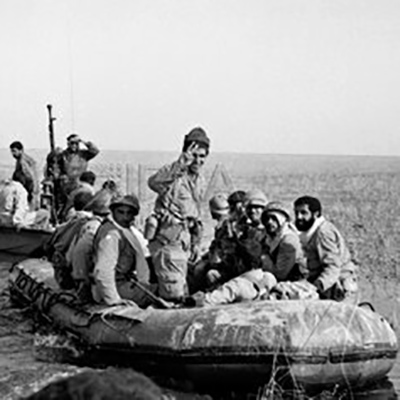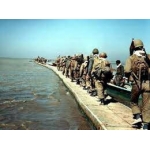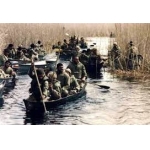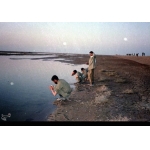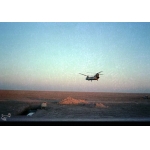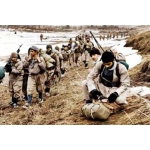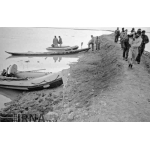Battles
Operation Kheibar
Leila Azadeh
201 دورہ
Planned by the Khatam al-Anbiya (pbuh) Headquarters, Operation Kheibar was the first amphibious attack carried out by the Iranian Armed Forces in the southern Hoor al-Hawizeh. It was executed by two operational headquarters: Karbala and Najaf. This operation laid the groundwork for future operations namely Badr, Valfajr 8, and Karbala 5.
Following Operation Ramazan, the sandy region of Fakkeh and the flooded marshlands (Hoor) were considered as potential battlegrounds against the enemy. Subsequently, Operation Preliminary Valfajr and Operation Kheibar were carried out in these areas.[1]
The objective of Operation Kheibar was to destroy Iraq’s 3rd Army Corps, secure the northern and southern Majnoon Islands, facilitate the attacks carried out from the islands and Talaieh region towards Nashwa, and link up with forces engaging in the Zaid frontline. There were also plans to advance through the marshes to seize the eastern bank of the Tigris River and sever the northern reinforcement routes to the Iraqi 3rd Corps.[2] The Kheibar operational area was located east of the Tigris River and within the Hoor al-Hawizeh marshlands. It extended from al-Uzair in the north to al-Qurna and Talaieh in the south, with one route running through the Zaid frontline. There were the northern and southern Majnoon Islands as well as facilities such as power transmission towers, radio and television relay towers, paper factories, and oil wells.[3]
The operation was carried out along two independent fronts: Hoor al-Hawizeh and Zaid.[4] Hoor al-Hawizeh (also known as Hoor al-Azim) was a swampy area in the southwest of Hawizeh, located about 100 kilometers from Ahvaz.[5] Zaid was a military post north of the general Shalamcheh area, to the west of the Ahvaz–Khorramshahr Road. It was one of the initial invasion routes of Iraq which served as an access point to the Ahvaz–Khorramshahr Road.[6]
The responsibility to carry out the operation on the Hoor and Zaid fronts was assigned to the Najaf Headquarters (Islamic Revolutionary Guard Corps (IRGC)) and the Karbala Headquarters (Army) respectively. However, directed by the Khatam al-Anbiya (pbuh) Headquarters, the main and decisive part of the operation took place in the Hoor.[7]
Five main targets were identified for the Hoor: al-Uzair, al-Qurna, the northern and southern Majnoon Islands, Nashwa, and Talaieh. The IRGC formed several sub-headquarters—Nasr, Hadid, Hunain, Fath, and Badr—to execute the operation. On the Zaid front, the Army deployed the 21st, 77th, and 28th infantry divisions, the 81st, 16th, and 92nd armored divisions, and the IRGC participated with the 14th Imam Hussain (as) Division, the 7th Vali-Asr (as) Division, and the 72nd Muharram Armored Brigade, all under the command of the Karbala Headquarters (Army).[8]
One day before the operation, Iranian forces entered the marshlands and advanced through the waterways as much as possible to eliminate Iraqi ambush points. At 9:30 PM on February 22, 1984, the three-phase operation started under the code-name “Ya Rasulullah (pbuh)”.
In the first phase, Iranian forces were positioned in the al-Qurna strait and town, along the strategic Basra–Amarah Road and on the Majnoon Islands. In response, Iraq declared a state of emergency in the city of al-Amarah and began mobilizing and dispatching forces to the operational zone.[9]
In the second phase of the operation, the forces were supposed to advance from the Jofair area towards Talaieh and ultimately capture the city of Nashwa but they failed.[10] The enemy had become aware of the ongoing movement of the Iranians in Talaieh and identified the objectives of the attack. Consequently, it began clearing the area near the Basra–Amarah Road before engaging in Talaieh.
Even though Iranian forces controlled six kilometers of the Talaieh road and one Iraqi brigade had been destroyed, the narrowness of the area and heavy Iraqi firepower made it impossible to advance and link up with the Majnoon Islands front. As a result, the operation in Talaieh was halted. Therefore, the third phase was launched to consolidate Iranian positions on the Majnoon Islands.[11]
The shortest distance from the Iranian frontlines to dry land in this amphibious operation was over 13 kilometers, making ground-based support impossible. Even the newly established IRGC naval unit (Nuh Nabi (pbuh) Headquarters) which was tasked with providing transportation and logistical support through the marshes for the Karbala and Najaf headquarters as well as the Army Aviation (Havanirooz) could not achieve the operation’s objectives. Meanwhile, the enemy launched extensive chemical bombings across the operational area, using sulfur-based mustard blistering agents and the nerve agent Tabun. Due to these challenges, it became impossible for Iranian forces to fully secure the area, and they could only reinforce their position in the Majnoon Islands.[12]
In this operation, Havanirooz conducted 1300 flight hours with 90 helicopters, transporting 20000 infantry troops, delivering 200 tons of light and heavy ammunition, and evacuating 2000 wounded and martyred.[13]
During the fighting, Hussain Kharrazi the commander of the Imam Hussain (as) Division of the IRGC lost his right hand due to shrapnel. Also, Haj Muhammad Ebrahim Hemmat, commander of the 27th Muhammad Rasulullah (pbuh) Division, Akbar Zojaji, his first deputy, and Hamid Bakeri, deputy commander of the 31st Ashura Division were martyred in this operation.[14]
Throughout the three phases of Operation Kheibar, 23 enemy units were damaged by between 20 to 100 percent and a total of 16140 Iraqi soldiers were killed, wounded, or taken prisoner. Among the POWs were not only Iraqi officers, non-commissioned officers, and soldiers of the Jaysh al-Shaabi, but also mercenaries from Egypt, Sudan, Morocco, and Somalia. In total, 330 enemy tanks and armored vehicles, 6 aircraft, 9 helicopters, 200 vehicles, and a large number of light and heavy weapons were destroyed.[15] Iranian forces also captured 40 tanks and armored personnel carriers, 20 vehicles, dozens of anti-aircraft guns, several ammunition depots, and various military equipment.[16]
Furthermore, an area of 1180 square kilometers was seized, including 1000 square kilometers of marshlands, 140 square kilometers of the Majnoon Islands, and 40 square kilometers around the Talaieh region. This provided Iranian forces access to the oil wells in the area.[17]
Operation Kheibar resulted in the martyrdom of 1800 Iranian troops and injuries to 15000 others. In addition, 40 individuals were martyred and 2500 injured due to chemical attacks. Three Chinook helicopters from Havanirooz were destroyed. One of the helicopters was carrying 33 Basij combatants who were martyred when it was targeted by an Iraqi MiG aircraft.[18]
Operation Kheibar differed from previous ones in several ways. The battlefield environment, unit organization, operational planning, and combat tactics were all based on innovative approaches Iranians adopted. For example, over just two months, IRGC infantry units were transformed into amphibious ones. Each unit was equipped with 50 to 100 boats, and troops were trained in boat navigation and movement in water. As Iranian helicopters lacked night vision equipment, pilots from Havanirooz, the Air Force, and the Navy carried out nighttime flight drills in the Gavkhouni Swamp.[19]
Operation Kheibar was marked by the nationwide mobilization of 250 combat battalions and the stringent secrecy under which it was planned.[20] Another remarkable achievement was using the Kheibar Bridge, a 13-kilometer-long and 4-meter-wide floating bridge designed by the Engineering Research Center of the Jahad-e Sazandegi Organization. The bridge played a key role in securing the Majnoon Islands as light vehicles could cross it at a speed of up to 20 km/h, making it crucial for transporting troops and supplies.[21]
Although the primary goal of the operation—to cut off the Basra–Amarah Road—was not achieved, Iranian forces succeeded in capturing 1000 square Kilometers of flooded marshland in addition to the northern and southern Majnoon Islands.[22]
[1] Rashid, Mohsen, Atlas-e Jang-e Iran va Araq (Atlas of the Iran-Iraq War), Tehran, Markaz-e Motaleat va Tahqiqat-e Jang, 2nd ed., 1389, p. 72.
[2] Jazayeri, Seyyed Masoud, Majnoon – Morouri bar Amaliyat-haye Kheibar va Badr (Majnoon – A Review of Operations Kheibar and Badr), Qom, Nasim-e Hayat, 1384, p. 34.
[3] Modiriyat-e Bahrehdehi-ye Markaz-e Motaleat va Tahqiqat-e Jang, Amaliyat-e Kheibar – Tasarrof-e Jazayer-e Majnoon (Tarrahi, Ejra, Natayej, Baztabha) (Operation Kheibar – Capturing the Majnoon Islands: Design, Execution, Outcomes, Reflections), Tehran, Markaz-e Sepah, 2nd ed., 1387, Pp. 18, 19.
[4] Pourjabari, Pejman, Atlas-e Joghrafia-ye Hamaasi – Khuzestan dar Jang (Geographical Atlas of Heroism – Khuzestan in War), Tehran, Sarir, 1389, p. 170.
[5] Jazayeri, Seyyed Masoud, Ibid., p. 27.
[6] Khabargozari-ye Mizan Online (Mizan Online News Agency), https://www.mizanonline.ir/fa/news/144408.
[7] Modiriyat-e Bahrehdehi-ye Markaz-e Motaleat va Tahqiqat-e Jang, Ibid., Pp. 20, 22.
[8] Ibid., Pp. 20, 21, 23.
[9] Doroodian, Muhammad, Seiri dar Jang-e Iran va Araq – Khorramshahr ta Faw (A Survey of the Iran-Iraq War – From Khorramshahr to Faw), Vol. 2, Tehran, Markaz-e Sepah, 5th ed., 1378, p. 87.
[10] Soltani, Morteza, Havanirooz va Hamaase-ye Bozorg-e Kheibar (The Army Aviation and the Great Epic of Kheibar), Tehran, Sura Sabz, 1389, p. 28.
[11] Habibi, Abolqasem, Atlas-e Khuzestan dar Jang-e Aran va Iraq (Atlas of Khuzestan in the Iran-Iraq War), Tehran, Markaz-e Asnad va Tahqiqat-e Defa Muqaddas, 1393, Pp. 192, 194.
[12] Rashid, Mohsen, Ibid., p. 72; Alaei, Hussain, Ravand-e Jang-e Iran va Araq (The Course of the Iran-Iraq War), Vol. 2, Tehran, Marz-o-Boom, 1391, Pp. 57–59.
[13] Soltani, Morteza, Ibid., Pp. 29, 30.
[14] Doroodian, Muhammad, Ibid., Pp. 88–90.
[15] Habibi, Abolqasem, Karaname-ye Amaliyat-e Sepahiyan-e Eslam dar Hasht Saal-e Defa Muqaddas (Operational Record of the Musim Combatants in the Eight-Year Sacred Defense), Tehran, Edare-ye Ravabet-e Omumi va Entesharat-e Sepah Pasdaran, 5th ed., 1383, p. 94.
[16] Jafari, Mojtaba, Atlas-e Nabardhaye Mandegar (Atlas of Lasting Battles), Tehran, Sura Sabz, 35th ed., 1393, p. 96.
[17] Modiriyat-e Bahrehdehi-ye Markaz-e Motaleat va Tahqiqat-e Jang, Ibid., p. 32.
[18] Alaei, Hussain, Ibid., p. 62.
[19] Ibid., Pp. 46, 47.
[20] Rashid, Mohsen, Ibid., p. 72.
[21] Pourjabari, Pejman, Ibid., p. 180.
[22] Alaei, Hussain, Ibid., p. 59.




